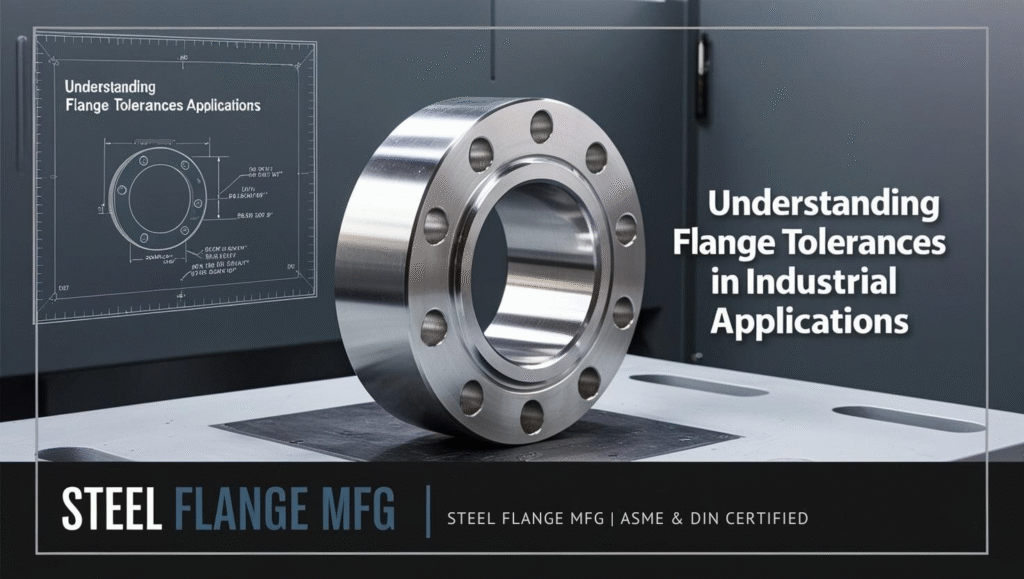Understanding the Importance of Flange Tolerances in Industrial Applications
Introduction
In the realm of industrial engineering and piping systems, precision is not optional—it is essential. Steel flanges serve as critical components that ensure leak-proof, secure, and reliable connections between pipes, valves, pumps, and other equipment. Among the many factors determining the effectiveness and reliability of flanges, dimensional tolerance plays a crucial role.
Flange tolerances define the allowable deviation from exact measurements during manufacturing. These tolerances are governed by internationally recognized standards such as ASME B16.5, DIN EN 1092-1, and ANSI B16.47, ensuring consistency and interchangeability across applications and industries. This blog explores why flange tolerances matter, what types exist, and how maintaining tight tolerances contributes to industrial systems’ safety, efficiency, and cost savings.

What Are Flange Tolerances?
Flange tolerance refers to the permissible variation in a flange’s dimensions from its nominal value. These variations can include:
- Outside Diameter (OD)
- Inner Diameter (Bore)
- Bolt Circle Diameter (BCD)
- Bolt Hole Diameter and Pitch
- Flange Thickness
- Raised Face Height
- Flatness and Face Finish
Each of these dimensions must fall within a certain acceptable range to ensure that the flange will align, fit, and seal properly when installed in a piping system.
Why Flange Tolerances Matter
1. Precision Ensures Leak-Proof Connections
In high-pressure and high-temperature applications such as oil & gas pipelines, power plants, or chemical processing facilities, even a slight deviation in dimensions can lead to poor gasket seating or misaligned bolt holes. This can result in leaks, pressure loss, or even dangerous failures.
2. Compatibility with International Standards
Many piping systems involve components sourced from different manufacturers. If the flanges do not comply with standard tolerance requirements, they may not match with other components, leading to installation delays and cost overruns. Compliance with standards like ASME, ANSI, DIN, and JIS ensures seamless compatibility and interchangeability.
3. Reduced Downtime and Rework
Flanges that are out of tolerance often require on-site modifications, reordering, or re-machining. This leads to increased project timelines, labor costs, and operational downtime. Precision-manufactured flanges eliminate these risks and ensure faster, trouble-free installations.
4. Safety in Critical Applications
Misalignment or improper sealing due to dimensional errors can cause joint failure under operating conditions. In industries such as oil refineries, petrochemicals, and thermal power plants, these failures can result in severe accidents. Maintaining proper flange tolerances contributes directly to operational safety.
How Flange Manufacturers Control Tolerances
At Steel Flange MFG, our manufacturing processes are aligned with international standards, and we utilize advanced technology to ensure dimensional accuracy in every flange we produce.
Key Methods:
- Precision CNC Machining: Computer-controlled systems ensure repeatable and accurate cuts within microns of tolerance.
- Calibrated Measuring Instruments: Digital calipers, gauges, and CMM (Coordinate Measuring Machines) help us verify all critical dimensions.
- In-Process Inspection: Continuous inspection during production minimizes deviations before the final product is ready.
- Final Dimensional Check: Before packaging, each flange undergoes a strict quality check to ensure it meets client specifications and relevant standards.
Tolerance Standards Reference Chart (Example)
| Flange Size (inches) | Tolerance in OD | Bolt Hole Pitch | Thickness Tolerance |
|---|---|---|---|
| 2″ – 4″ | ±0.5 mm | ±0.4 mm | ±0.3 mm |
| 6″ – 12″ | ±0.8 mm | ±0.6 mm | ±0.5 mm |
| 14″ and above | ±1.2 mm | ±0.8 mm | ±0.6 mm |
Note: These values are subject to ASME B16.5 and may vary based on material and type.
Common Issues Caused by Poor Flange Tolerances
- Gasket failure due to uneven sealing surfaces
- Bolt misalignment and stress concentration
- Vibration issues in rotating equipment
- Reduced flange life due to improper load distribution
- Repeated maintenance due to system leaks
Industries That Require Strict Tolerances
Oil & Gas: High-pressure pipelines and offshore rigs
Power Generation: Steam lines, heat exchangers
Petrochemical Plants: Chemical-resistant flanges for processing
Pharmaceuticals: Sanitary flange tolerances for sterile systems
Marine & Shipping: High-strength corrosion-resistant flange assemblies
Conclusion
Maintaining accurate flange tolerances is not just about following specifications—it’s about ensuring reliability, safety, and efficiency in critical operations. Whether your project involves high-pressure pipelines, corrosive fluids, or temperature extremes, tolerance-controlled flanges ensure seamless assembly, secure sealing, and long-term performance.
At Steel Flange MFG, we pride ourselves on delivering flanges with precision machining, certified quality control, and global-standard compliance. Our commitment to accuracy ensures that you receive products that perform as expected—every time.
Contact Us
Looking for custom flange solutions with tight tolerances? Contact our team today.
Email: info@steelflangemfg.com
Call/WhatsApp: +91 93511 11359
Website: www.steelflangemfg.com
